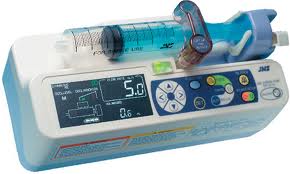
 |
Upload | Sign in/out |
|---|
A syringe driver or syringe pump is a small infusion pump used to gradually administer small amounts of fluid (with or without medication) to a patient or for use in chemical and biomedical research.
The most popular use of syringe drivers is in palliative care, to continuously administer analgesics (painkillers), antiemetics (medication to suppress nausea and vomiting) and other drugs. This prevents periods during which medication levels in the blood are too high or too low, and avoids the use of multiple tablets.
BASIC CONSTRUCTION:
• Syringe-type pumps generally consist of a cylinder that holds the mobile phase which is expelled by a piston.
• The piston is advanced by a motor connected through worm gears, to provide smooth pulse less flow. Figure below shows the schematic of a typical syringe pump.
• Syringe pumps have a number of advantages. Pressure capability is generally quite high (up to 78,000 psi) and maintenance is infrequent since there are no fluctuating check valves; gears are simple and strong.

• The disadvantages of the system are the limited possibilities to form gradients and the limited reservoir capacity.
• Widely used in the early stages of HPLC, syringe pumps are now mostly used for SFC and microcolumn chromatography where the flow rates are 1 - 100 l/min. The 20 ml reservoir capacity is more than enough for the whole day operation.
• Two of these pumps can be easily combined and driven through an electronic system which provides mixed mobile phase and gradient-programming operation, or drive can be arranged synchronously so that one pump can be refilled while the other is operating in order to obtain continuous elution.

Applications:
• Syringe drivers are also useful for delivering IV medications over several minutes. In the case of a medication which should be slowly pushed in over the course of several minutes, this device saves staff time and reduces errors.
• Syringe pumps are also useful in micro fluidic applications, such as micro reactor design and testing, and also in chemistry for slow incorporation of a fixed volume of fluid into a solution.